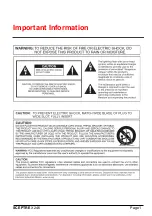
14
FUEL 3100 / DIESEL 3200
Installation and Operation Manual
NAVMAN
3-4 Fuel calibration
(
CAL.F
)
To calibrate a fuel flow sensor, select
CAL.F
in
the
FUEL
menu. Calibrate the sensors if you are
doubtful of their performance.
FUEL 3100
: It is essential to calibrate the fuel
flow sensors after installation and again after
the first 100 engine hours to allow moving parts
to wear in.
DIESEL 3200
: The sensors are factory calibrated
and are highly accurate. They can be calibrated
but this should not be necessary.
Calibrating a fuel flow sensor requires accurate
measurement of the fuel consumption. This is
best done using a small portable tank. At least 4
gallons (15 litres) of fuel should be used to ensure
an accurate calibration. The more fuel used, the
more accurate the calibration.
Twin engine boats require both engines to
be calibrated. Do these together with two
portable tanks, or at different times using one
portable tank.
To calibrate an engine’s fuel flow sensor:
1 Connect the portable tank to the
engine through the fuel flow sensor.
2 Reset
USED
:
i Press one or more times
until
USED
is displayed.
ii If your boat has twin tanks,
press
ENT
one or more times
to display
PORT
or
STBD
.
iii Hold
ENT
and together until
the reading resets to zero.
3 Run the engine at normal cruising
speed until a
known
amount of
fuel, at least 15 litres (4 gallons),
has been used per engine.
4 Select the
FUEL
setup menu, then
select
CAL.F
; if your boat has twin
engines, select the
PORT
or
STBD
engine
to be calibrated (see section 3-1).
5 If the value of
CAL.F
does not match
the
known
amount of fuel used, press
ENT
, then press or and change
CAL.F
until it does match. Then press
ENT
to save the correct value (otherwise
press
ESC
to ignore the calibration).
3-5 Fuel flow damping
(
dAmP.F
)
Waves and rocking of the boat cause the fuel
flow to fluctuate slightly. To give a stable reading,
the instrument calculates flow by taking several
measurements over a period of time and
averaging them. This is called damping.
Set
dAmP.F
to between 1 to 99 seconds. Small
values will give more accurate readings but
will show fluctuations. Large values will give
more stable readings, but will ignore some
true fluctuations.
3-6 Speed input
(
InPUt
)
Select the optional speed input:
No
: No speed input is available.
GPS
: Use GPS speed received via
NMEA. This is speed over ground.
SEn
: The optional paddlewheel
sensor connected directly to the
unit, or through the Navbus system.
This is speed through water.
Note:
A speed input is required to display
LOG
,
TOTAL LOG
,
RANGE
and
SPEED
(see
section 2-5).
Speed over ground and speed through water
can give different values for some displayed data
(see appendix C).
3-7 Speed damping
(
dAmP.S
)
(Only available if an optional paddlewheel sensor
is connected to the unit and
InPUt
=
SEn
.)
Waves and rocking of the boat cause the speed
to fluctuate slightly. To give a stable reading,
the instrument calculates speed by taking
several measurements over a period of time and
averaging them. This is called damping.
Set
dAmP.S
to 1 (6 sec), 2 (12 sec), 3 (18 sec), 4
(24 sec) or 5 (30 sec). Small values will give more
accurate readings but will show fluctuations.
Large values will give more stable readings, but
will ignore some true fluctuations.














































